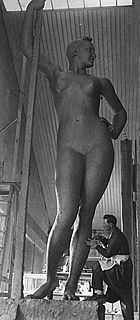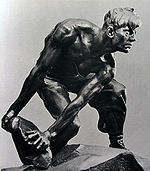
Ivan Shadr
Encyclopedia

Russia
Russia or , officially known as both Russia and the Russian Federation , is a country in northern Eurasia. It is a federal semi-presidential republic, comprising 83 federal subjects...
n/Soviet sculptor
Sculpture
Sculpture is three-dimensional artwork created by shaping or combining hard materials—typically stone such as marble—or metal, glass, or wood. Softer materials can also be used, such as clay, textiles, plastics, polymers and softer metals...
and medalist who took his pseudonym after his hometown of Shadrinsk
Shadrinsk
Shadrinsk is a town in Kurgan Oblast, Russia, located on the left bank of the Iset River northwest of Kurgan. Population: -Climate:...
.
Life
Shadr studied at the Artistic Industrial School in YekaterinburgYekaterinburg
Yekaterinburg is a major city in the central part of Russia, the administrative center of Sverdlovsk Oblast. Situated on the eastern side of the Ural mountain range, it is the main industrial and cultural center of the Urals Federal District with a population of 1,350,136 , making it Russia's...
from 1903 to 1907, and from 1907 to 1908 at the Drawing School of the Society for the Encouragement of the Arts in St Petersburg where the famous Nicholas Roerich
Nicholas Roerich
Nicholas Roerich, also known as Nikolai Konstantinovich Rerikh , was a Russian mystic, painter, philosopher, scientist, writer, traveler, and public figure. A prolific artist, he created thousands of paintings and about 30 literary works...
was his teacher. He furthered his education under Auguste Rodin
Auguste Rodin
François-Auguste-René Rodin , known as Auguste Rodin , was a French sculptor. Although Rodin is generally considered the progenitor of modern sculpture, he did not set out to rebel against the past...
and Emile-Antoine Bourdelle in Paris
Paris
Paris is the capital and largest city in France, situated on the river Seine, in northern France, at the heart of the Île-de-France region...
(1910–1911), and in Rome
Rome
Rome is the capital of Italy and the country's largest and most populated city and comune, with over 2.7 million residents in . The city is located in the central-western portion of the Italian Peninsula, on the Tiber River within the Lazio region of Italy.Rome's history spans two and a half...
(1911 – 1912).
Shadr's early works, such as the project for the memorial to World Suffering (1916), were designed according to the principles of Art Nouveau
Art Nouveau
Art Nouveau is an international philosophy and style of art, architecture and applied art—especially the decorative arts—that were most popular during 1890–1910. The name "Art Nouveau" is French for "new art"...
. After the 1917 Revolution
Revolution
A revolution is a fundamental change in power or organizational structures that takes place in a relatively short period of time.Aristotle described two types of political revolution:...
he was an active participant in the execution of the Monumental Propaganda Plan, in particular, he sculptured reliefs depicting the Socialist ideological leaders Karl Marx
Karl Marx
Karl Heinrich Marx was a German philosopher, economist, sociologist, historian, journalist, and revolutionary socialist. His ideas played a significant role in the development of social science and the socialist political movement...
, Karl Liebknecht
Karl Liebknecht
was a German socialist and a co-founder with Rosa Luxemburg of the Spartacist League and the Communist Party of Germany. He is best known for his opposition to World War I in the Reichstag and his role in the Spartacist uprising of 1919...
, and Rosa Luxemburg
Rosa Luxemburg
Rosa Luxemburg was a Marxist theorist, philosopher, economist and activist of Polish Jewish descent who became a naturalized German citizen...
, as well as some sixteen separate monuments to Vladimir Lenin
Vladimir Lenin
Vladimir Ilyich Lenin was a Russian Marxist revolutionary and communist politician who led the October Revolution of 1917. As leader of the Bolsheviks, he headed the Soviet state during its initial years , as it fought to establish control of Russia in the Russian Civil War and worked to create a...
.
In these years the characteristics of Shadr’s style were consolidated: an elevated, romantic
Romanticism
Romanticism was an artistic, literary and intellectual movement that originated in the second half of the 18th century in Europe, and gained strength in reaction to the Industrial Revolution...
organization of the figures and an emotional, dynamic composition. Among his most famous and characteristic works are sculptures Stone as a weapon of the proletariat
Proletariat
The proletariat is a term used to identify a lower social class, usually the working class; a member of such a class is proletarian...
(1927) and Woman with an Oar (1936).
In the 1920s, Shadr together with sculptor Piotr Tayozhny came up with one of the first design
Design
Design as a noun informally refers to a plan or convention for the construction of an object or a system while “to design” refers to making this plan...
s of the Order of Lenin
Order of Lenin
The Order of Lenin , named after the leader of the Russian October Revolution, was the highest decoration bestowed by the Soviet Union...
, the highest Soviet award
Award
An award is something given to a person or a group of people to recognize excellence in a certain field; a certificate of excellence. Awards are often signifiedby trophies, titles, certificates, commemorative plaques, medals, badges, pins, or ribbons...
. Shadr also worked for Goznak
Goznak
Goznak is a Unitary enterprise in Russia, responsible for the production of coins and bank notes. Goznak was established on July 6, 1919, under the conditions of civil war, as an agency that administered the whole process cycle of bank note manufacturing. It incorporated several factories involved...
, including on designing new Soviet money
Money
Money is any object or record that is generally accepted as payment for goods and services and repayment of debts in a given country or socio-economic context. The main functions of money are distinguished as: a medium of exchange; a unit of account; a store of value; and, occasionally in the past,...
that included the symbols of that time: a worker, a peasant and a Red Army
Red Army
The Workers' and Peasants' Red Army started out as the Soviet Union's revolutionary communist combat groups during the Russian Civil War of 1918-1922. It grew into the national army of the Soviet Union. By the 1930s the Red Army was among the largest armies in history.The "Red Army" name refers to...
soldier. Those sculptures remarkable for their vigorous and dynamic typical characters can be seen nowadays in the Russian Museum
Russian Museum
The State Russian Museum is the largest depository of Russian fine art in St Petersburg....
(plaster casts) and in the Tretyakov Gallery
Tretyakov Gallery
The State Tretyakov Gallery is an art gallery in Moscow, Russia, the foremost depository of Russian fine art in the world.The gallery's history starts in 1856 when the Moscow merchant Pavel Mikhailovich Tretyakov acquired works by Russian artists of his day with the aim of creating a collection,...
(bronze sculptures).
Shadr died in wartime Moscow and in 1952 was awarded the Stalin Prize posthumously. He's buried in Novodevichy Cemetery
Novodevichy Cemetery
Novodevichy Cemetery is the most famous cemetery in Moscow, Russia. It is next to the 16th-century Novodevichy Convent, which is the city's third most popular tourist site. It should not be confused with the Novodevichy Cemetery in Saint Petersburg....
in Moscow, where his sculptural work can also been seen at the grave of Nadezhda Alliluyeva, the second wife of Stalin, and the grave of theater director Vladimir Nemirovich-Danchenko
Vladimir Nemirovich-Danchenko
Vladimir Ivanovich Nemirovich-Danchenko was a Georgian-born Russian theatre director, writer, pedagogue, playwright, producer and theatre organizer, who founded the Moscow Art Theatre with his colleague, Konstantin Stanislavsky, in 1898.-Biography:Vladimir Ivanovich Nemirovich-Danchenko was born...
.
Selected work

- Stone as a weapon of the proletariat, bronze, 1927, multiple versions
- colossal figure of Lenin at the Zemo-Avchaly hydroelectric power station (ZAGES), near TbilisiTbilisiTbilisi is the capital and the largest city of Georgia, lying on the banks of the Mt'k'vari River. The name is derived from an early Georgian form T'pilisi and it was officially known as Tiflis until 1936...
, 1927, removed 1991 - Woman with an Oar, multiple versions created 1935 and 1936

